The AMD Radeon R9 Fury Review, Feat. Sapphire & ASUS
by Ryan Smith on July 10, 2015 9:00 AM ESTCompute
Shifting gears, we have our look at compute performance. As compute performance will be more significantly impacted by the reduction in CUs than most other tests, we’re expecting the performance hit for the R9 Fury relative to the R9 Fury X to be more significant here than under our gaming tests.
Starting us off for our look at compute is LuxMark3.0, the latest version of the official benchmark of LuxRender 2.0. LuxRender’s GPU-accelerated rendering mode is an OpenCL based ray tracer that forms a part of the larger LuxRender suite. Ray tracing has become a stronghold for GPUs in recent years as ray tracing maps well to GPU pipelines, allowing artists to render scenes much more quickly than with CPUs alone.

For LuxMark with the R9 Fury X already holding the top spot, the R9 Fury cards easily take the next two spots. One interesting artifact of this is that the R9 Fury’s advantage over the GTX 980 is actually greater than the R9 Fury X’s over the GTX 980 Ti’s, both on an absolute and relative basis. This despite the fact that the R9 Fury is some 13% slower than its fully enabled sibling.
For our second set of compute benchmarks we have CompuBench 1.5, the successor to CLBenchmark. CompuBench offers a wide array of different practical compute workloads, and we’ve decided to focus on face detection, optical flow modeling, and particle simulations.
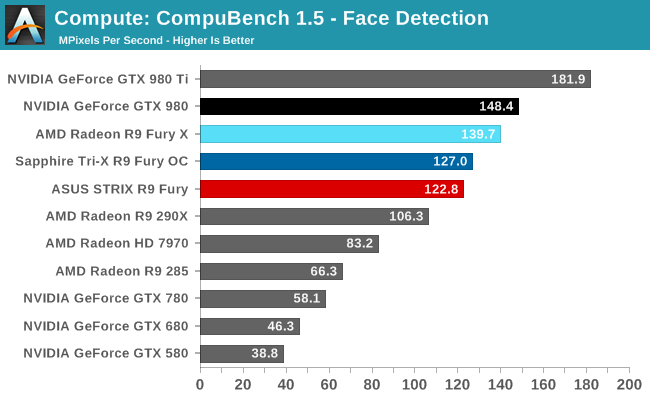
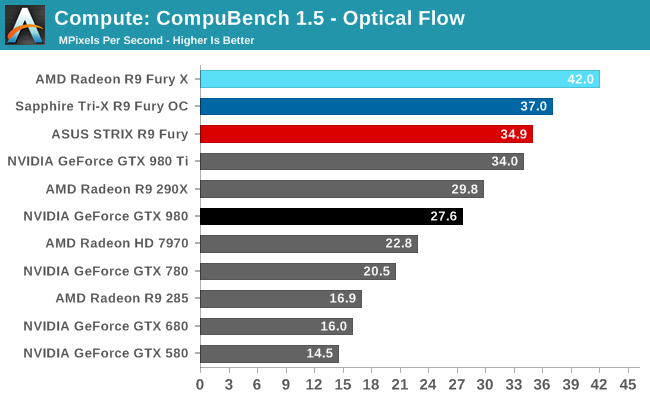

Not unlike LuxMark, tests where the R9 Fury X did well have the R9 Fury doing well too, particularly the optical flow sub-benchmark. The drop-off in that benchmark and face detection is about what we’d expect for losing 1/8th of Fiji’s CUs. On the other hand the particle simulation benchmark is hardly fazed beyond the clockspeed drop, indicating that the bottleneck lies elsewhere.
Our 3rd compute benchmark is Sony Vegas Pro 13, an OpenGL and OpenCL video editing and authoring package. Vegas can use GPUs in a few different ways, the primary uses being to accelerate the video effects and compositing process itself, and in the video encoding step. With video encoding being increasingly offloaded to dedicated DSPs these days we’re focusing on the editing and compositing process, rendering to a low CPU overhead format (XDCAM EX). This specific test comes from Sony, and measures how long it takes to render a video.
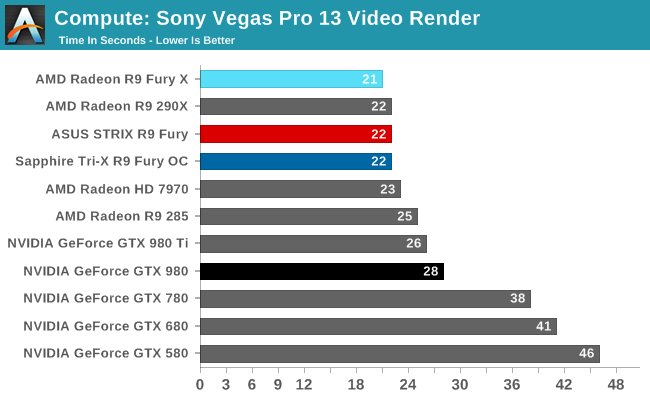
At this point Vegas is becoming increasingly CPU-bound and will be due for replacement. The R9 Fury comes in one second behind the chart-topping R9 Fury X, at 22 seconds.
Moving on, our 4th compute benchmark is FAHBench, the official Folding @ Home benchmark. Folding @ Home is the popular Stanford-backed research and distributed computing initiative that has work distributed to millions of volunteer computers over the internet, each of which is responsible for a tiny slice of a protein folding simulation. FAHBench can test both single precision and double precision floating point performance, with single precision being the most useful metric for most consumer cards due to their low double precision performance. Each precision has two modes, explicit and implicit, the difference being whether water atoms are included in the simulation, which adds quite a bit of work and overhead. This is another OpenCL test, utilizing the OpenCL path for FAHCore 17.
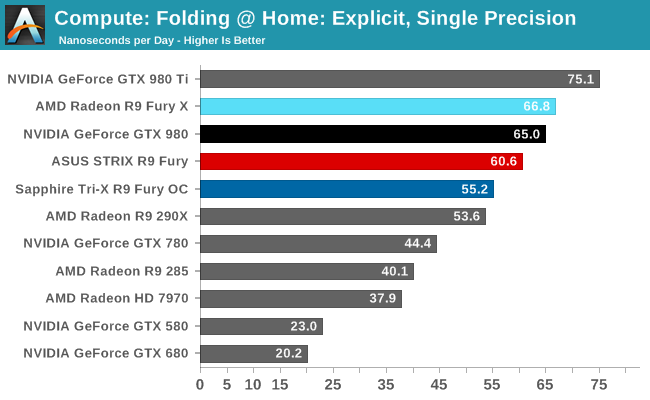
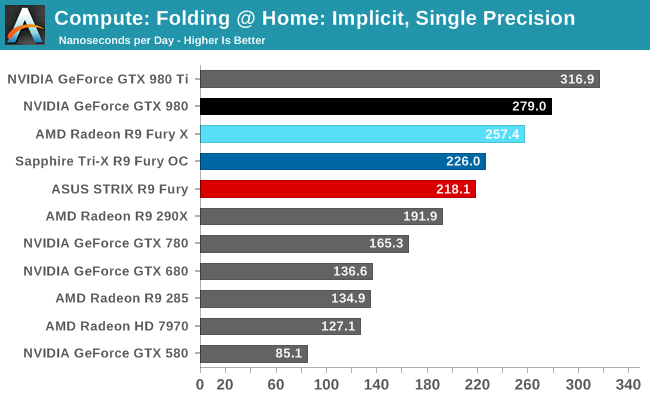

Overall while the R9 Fury doesn’t have to aim quite as high given its weaker GTX 980 competition, FAHBench still stresses the Radeon cards. Under single precision tests the GTX 980 pulls ahead, only surpassed under double precision thanks to NVIDIA’s weaker FP64 performance.
Wrapping things up, our final compute benchmark is an in-house project developed by our very own Dr. Ian Cutress. SystemCompute is our first C++ AMP benchmark, utilizing Microsoft’s simple C++ extensions to allow the easy use of GPU computing in C++ programs. SystemCompute in turn is a collection of benchmarks for several different fundamental compute algorithms, with the final score represented in points. DirectCompute is the compute backend for C++ AMP on Windows, so this forms our other DirectCompute test.
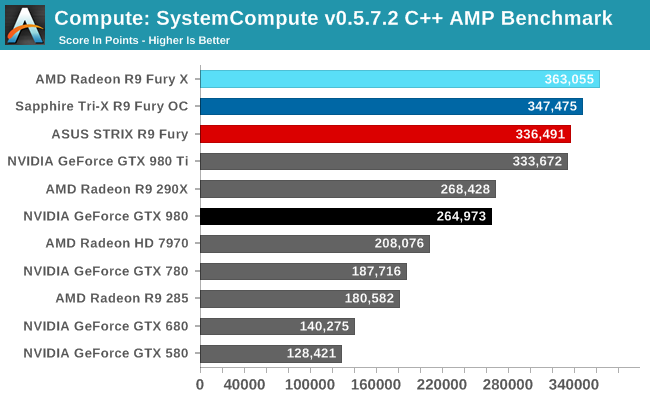
As with our other tests the R9 Fury loses some performance on our C++ AMP benchmark relative to the R9 Fury X, but only around 8%. As a result it’s competitive with the GTX 980 Ti here, blowing well past the GTX 980.










288 Comments
View All Comments
FlushedBubblyJock - Thursday, July 16, 2015 - link
i'VE ALREADY SEEN A DOZEN REFUSE TO BUY FURY BECAUSE OF IT.They have a 4k TV, they say, that requires the hdmi 2.0...
SO ALL YOUR PATHETIC EXCUSES MEAN EXACTLY NOTHING. THOSE WITH 4K READY SCREENS ARE BAILING TO NVIDIA ONLY !
YOU DENYING REALITY WILL ONLY MAKE IT WORSE FOR AMD.
They can screw off longer with enough pinheads blabbering bs.
FlushedBubblyJock - Thursday, July 16, 2015 - link
It's such a massive failure, and so big a fat obtuse lie, it's embarrassing to even bring up, spoiling the party that is fun if you pretend and fantasize enough, and ignore just how evil amd is.hdmi 2.0 - nope ! way to go what a great 4k gaming card ! 4gb ram - suddenly that is more than enough and future proof !
ROFL - ONLY AMD FANBOYS
dave1231 - Saturday, July 11, 2015 - link
That's with HBM? Lol.medi03 - Saturday, July 11, 2015 - link
With all respect, 300 vs 360 watt at load and 72 vs 75 watt idle doesn't deserve "consumes MUCH more power", Ryan, and that even if it wasn't a faster card.Socius - Saturday, July 11, 2015 - link
For total system power draw? Yeah it does....because the power usage gap percentage is lessened by the addition of the system power usage (minus the cards) in the total figure. So if the numbers were 240W vs 300W, for example, that's 25% more power usage. And that's with a 20-30W reduction in power usage by using HBM. So it shows how inefficient the GPU design actually is, even when asking it with HBM power reduction and the addition of total system power draw instead of calculating it by card.mdriftmeyer - Sunday, July 12, 2015 - link
Personally, I have an RM 1000W Corsair Power Supply. Sorry, but if you're using < 850W supply units I suggest you buck up and upgrade.Socius - Sunday, July 12, 2015 - link
I think you replied to the wrong person here. I have 2 PSUs in my PC. A 6-rail 1600W unit and a single rail 1250W unit.Peichen - Saturday, July 11, 2015 - link
The fail that’s AMD’s Fury series makes my MSI Gaming 4G GTX980 looks even better. I only paid $430 for it and it gets to 1490/1504 boosted at stock voltage. Essentially it means I got a card as fast as Fury OC at $100+ cheaper, uses far less power and in my system for months earlier.I am very glad I went Nvidia after 5 year with AMD/ATI graphics and didn’t wait months for Fiji.
FlushedBubblyJock - Thursday, July 16, 2015 - link
There we have it, and it's still the better deal. It's STILL THE BETTER DEAL AND IT'S AVAILABLE.But we're supposed to believe amd is cheap and faster... and just as good in everything else...
I seriously can't think of a single thing amd isn't behind on.
MobiusPizza - Saturday, July 11, 2015 - link
"The R9 Fury will be launching with an MSRP of $549, $100 below the R9 Fury X. This price puts the R9 Fury up against much different completion* than its older sibling; "It's competition not completion